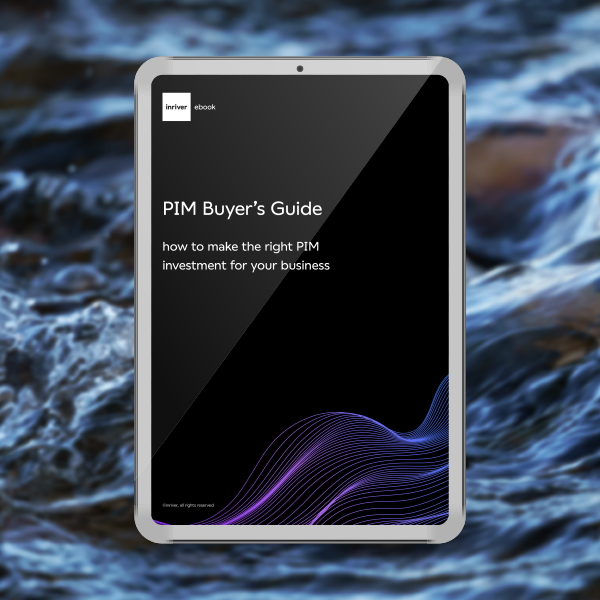What is PIM integration?
choose the right tools to get more from PIM
Maximizing ROI on Product Information Management software starts with integration that meets your unique needs.
As demands for product data evolve and increase, Product Information Management software is becoming an increasingly business-critical application for brands and manufacturers across all industries.
At a high level, PIM is a centralized management system for all product-related information. With a PIM at the heart of your tech stack, you can onboard raw product data from across the supply chain, transform it into enriched product information, and distribute it across all your channels.
Thanks to the single source of truth PIM provides, you can secure a unified approach to commerce across even the most complex omnichannel strategy and promote better decision-making at every touchpoint. However, to enjoy the many benefits of PIM, it’s essential to start with the right integration of your PIM system.
But how do PIM integrations work, and how can an advanced PIM solution ensure your integration goes off without a hitch? Flexible PIM architecture, API efficiency, and a product-centric integration model are all keys to success.
PIM integration benefits
The modern tech stack is constantly evolving. In the context of this broader technology infrastructure—such as Salesforce Commerce Cloud or Adobe Magento—PIM integration delivers major advantages:
- Single source of truth: Integrating PIM provides a centralized platform for all product-related data onboarded from across the value chain, for all internal workflows and external endpoints.
- Enhanced customer experiences: PIM integration ensures reliable and consistent product data across all channels and touchpoints. This consistency is key to building trust and fostering customer loyalty.
- Improved efficiency: Automated PIM data synchronization eliminates manual duplication of product information between systems, which means internal teams are freed up to focus on revenue-generating initiatives.
- Supply chain transparency: PIM integration aids in achieving transparency from source to sales channel. This is crucial for regulatory compliance and demonstrating sustainability commitments, which are increasingly important to consumers.
- Agility to scale: With an integrated tech architecture, adding new sales channels, expanding into new regions, or mergers and acquisitions can happen faster without disruptive data migrations.
However, only with complete and comprehensive PIM integration can businesses realize these benefits. That’s why the inriver PIM is equipped for seamless PIM-ERP integration and other platform integrations, enabling complete product alignment from source to after-sale. What’s more, the integration model is unique to each customer and their unique products of interest, helping you deliver the most personalized experiences possible.

Technical challenges of PIM integration
Implementing a PIM system within an organization’s existing framework is not without its challenges. These complexities can impact the effectiveness of the integration and, consequently, the overall business operations:
- Data inconsistencies: One of the primary challenges is ensuring data consistency across all platforms. If the integration is not meticulously executed, discrepancies in product data can arise between different systems. This can lead to poor customer experiences as they encounter conflicting information across various touchpoints.
- Complex integration process: PIM e-commerce integration processes, similar to those of ERPs or other enterprise systems, often require individuals with specialized expertise in each of those platforms.
- Ongoing optimization: Post-integration, monitoring, and optimizing is a must—but it’s easier said than done. As business systems evolve, with updates and changes being a regular occurrence, the PIM integration must also adapt, evolve, and grow with the organization.
- Navigating omnichannel environments: The omnichannel strategies that underpin marketing initiatives for brands, manufacturers, and retailers can also contribute to more challenging integrations. Integrating a strong PIM solution with syndication capabilities is necessary to handle the complex, multi-channel environment.
To address these challenges, leading PIM solutions like inriver offer an advanced integration framework. The inriver PIM is equipped with hundreds of pre-built integrations while leveraging modern APIs and web services, ensuring you have the platform you need to drive excellence across all channels.
This approach simplifies the integration process, enabling seamless connectivity across a range of systems and reducing the technicalities associated with custom-built solutions.
Why PIM integration matters for e-commerce
For brands, manufacturers, and retailers competing in an always-on online market, having a PIM in the center of an omnichannel strategy plays a critical role in optimizing omnichannel product experiences and personalizing buyer journeys.
By presenting accurate, up-to-date product data across channels, including correct pricing, inventory availability, attributes, and sustainability information, customers can feel confident in receiving product information they can trust—a factor proven to influence shopping decisions.
In addition, providing relevant, on-brand digital assets improves product storytelling and discoverability at every touchpoint. Keeping metadata, content, and attributes current improves visibility in both site search and external search engines. And by simplifying data management, internal teams can be confident they’re working with unified data—reducing errors, saving time, and empowering customer-centric strategies.
With so many elements impacting conversions online, any inaccuracies or data inconsistencies due to integration gaps can directly result in lost sales. An integrated PIM solution makes sure all your product information is consistent across channels and internal documentation so that both customer experiences and internal experiences are consistently positive.

Why PIM integration matters for supply chain transparency
For manufacturers and distributors, integrating a PIM system helps meet stringent industry regulations and compliance mandates around supply chain transparency.
The consistent data provided by an integrated PIM also provides end-to-end visibility into sourcing, components, transformations, and sustainability across the value chain. This facilitates tracing products downstream to end markets, as well as upstream to origins so that organizations can:
- Closely monitor and optimize the environmental footprint of all materials, logistics, and production processes
- Confirm ethical sourcing and responsible supplier practices are being met, creating a basis for sustainability KPI reporting
In today’s market, it’s clear that consumers are more informed and concerned about the products they purchase. PIM integration empowers companies to provide the transparency that consumers demand, building trust and loyalty that leads to sales.
Moreover, maintaining accurate and interconnected product records aligns organizations with increasingly stringent regulatory standards. This dual benefit of PIM integration underscores its necessity in the modern business ecosystem.
PIM integration: How to implement
Choosing an advanced, enterprise-grade PIM solution designed for seamless integration is the critical first step for implementation.
The inriver PIM delivers out-of-the-box integration with major e-commerce platforms and tools using the latest APIs and web services. This enables organizations to quickly integrate inriver with existing infrastructure to ensure synchronized data across channels.
Consider the following key integrations inriver facilitates:
PIM Integration with Salesforce B2B Commerce
The inriver PIM seamlessly integrates with Salesforce B2B Commerce to share complete, accurate product and customer data. Real-time synchronization ensures product, customer, and other attributes flow instantly between inriver and Salesforce.
With this adapter, you can create your product stories in inriver and then schedule when you want the Salesforce B2B Commerce Adapter to automatically supply product catalog data, including product content and categories, directly into Salesforce B2B Commerce.
This ensures that the latest, accurate product content is used consistently across all your channels, enhancing engagement, loyalty, and conversion.

PIM integration with Salesforce B2C Commerce Cloud
Similarly, inriver integrates with Salesforce Commerce Cloud (B2C) to power consumer-facing product experiences with reliable, consistent data across channels. This way, changes made in inriver automatically propagate to Commerce Cloud without IT involvement.
Key benefits include:
- Easy enrichment of high-quality product information in inriver PIM
- Faster time-to-market for products
- A flexible inriver Marketing Model that adapts to changing business needs
- Seamless publishing of products and resources to Salesforce Commerce
With this ready-to-go adapter, data deployment is simplified and unified across all touchpoints, from web and social to mobile and in-store.
PIM integration with SAP Commerce Cloud
For SAP customers, inriver integrates out-of-the-box with SAP Commerce Cloud (formerly Hybris). This enables the SAP platform to leverage inriver as the centralized product information hub across all channels and enterprise systems.
This integration offers benefits such as:
- Updates that sync bi-directionally in real time
- B2B, B2C, and B2B2C customization options
- Automatic sharing with SAP Customer Experience portfolio
Without a custom integration to develop or maintain, the implementation process is straightforward, with inriver providing support the whole way.
PIM and DAM integration
Integrating PIM with Digital Asset Management (DAM) systems builds a robust bridge between product data and creative assets.
Using a DAM as the centralized hub for maintaining rich media content is in itself a wise investment. However, the functionality and return on investment are elevated when integrated with PIM. In a PIM-DAM integration, assets from a DAM can be directly connected to a PIM. This can be used to enrich product data and transform your customers’ shopping experience. To fully understand the financial benefits of integrating the two, you should consider the ROI of PIM as a significant factor as well.
With real-time synchronization of updates between the integrated PIM and DAM solutions, organizations can ensure the right creative assets remain tied directly to the current product details. This maximizes the impact of product content across customer touchpoints while optimizing ROI on existing DAM solutions.

inriver: Seamless PIM integration for every tech stack
With data accuracy driving everything from supply chain transparency to customer conversion, integrating a robust PIM system across your tech stack is imperative. An integrated PIM eliminates data discrepancies through real-time synchronization to provide impactful product experiences on the digital shelf.
To realize the full benefits of PIM, companies need inriver’s enterprise-level solution that supports seamless integration. With out-of-the-box connectivity across major e-commerce, ERP, and today’s most popular systems, inriver enables organizations to unlock the power of integrated PIM sooner.
want to see the inriver PIM in action?
Schedule a personalized, guided demo with an inriver expert today to see how the inriver PIM can get more value from your product information.
